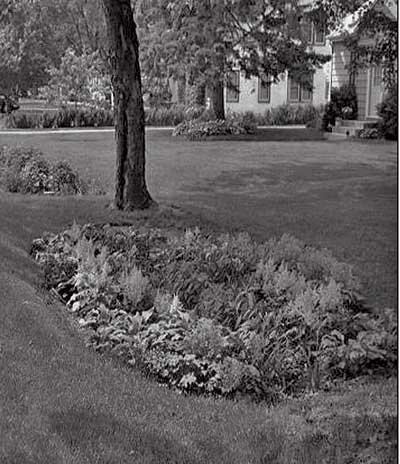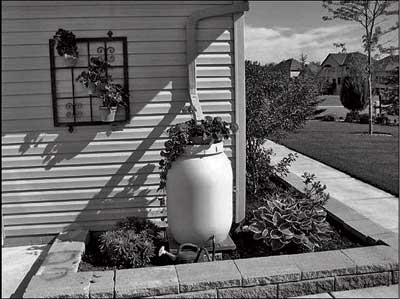Small Home Gazette, Summer 2009
Rain Gardens and Rain Barrels
Even if you don’t live in suburbia, managing storm water runoff is something to consider in your landscape. Preventing erosion and keeping nutrients out of lakes or rivers doesn’t start at the shoreline. Roof tops, roads, driveways and sidewalks are impervious surfaces (surfaces that do not absorb water). When water is not absorbed, it tends to run off the land in greater volumes and with greater force after a storm, causing erosion and allowing nutrients and sediments to drain into lakes and rivers. Adding a rain garden and/or capturing rooftop runoff using a rain barrel are two practices that can help to slow the pace at which storm water enters our natural waterways.
Rain Gardens
 Simply put, rain gardens are shallow, plant-filled depressions designed to allow rain to infiltrate the soil, filtering out pollutants as the water seeps into the water table. Rain gardens allow plants to absorb nutrients and sediments to settle. Rain may be channeled away from structures into a rain garden, preventing seepage.
Simply put, rain gardens are shallow, plant-filled depressions designed to allow rain to infiltrate the soil, filtering out pollutants as the water seeps into the water table. Rain gardens allow plants to absorb nutrients and sediments to settle. Rain may be channeled away from structures into a rain garden, preventing seepage.
Rain gardens filled with small shrubs, flowering plants and ornamental grasses add beauty to the landscape and may attract butterflies and birds. Well-placed rain gardens can be interesting and enjoyable to see from indoors and out.
Like any garden design, rain gardens can be simple or elaborate. To insure satisfaction, sketch out the desired design before you start.
When designing a rain garden, consider desired size, soil type and plant species. Rain gardens can be designed in any shape. Crescent or kidney shapes are attractive, but a long and narrow rain garden may be better suited to fitting between structures or between house and sidewalk.
Often several rain gardens are designed into the home landscape. For rooftop runoff, generally one rain garden is placed at each downspout at low points in the lawn. Each rain garden should be about one-third the size of the area that is being drained. For example, at a 3000-square-foot home with four downspouts, each rain garden would be approximately 250 square feet. In sandy soil, the size can be smaller, but for heavy clay, a larger area may be required. Rain gardens may be built applying these same concepts to control runoff from other impervious surfaces, such as driveways and sidewalks.
The rain garden depression should be placed 10 feet or more away from foundations, so seepage doesn’t occur. Remember to always call Gopher State One Call (800-252-1166) before digging to prevent cutting into an electrical line or cable.
Once the size, shape and location of the rain garden have been decided, construction can begin. Lay out a rope or garden hose in the shape desired as a guide for digging. In most cases, the depth of the depression may vary from 4 to 8 inches. For best infiltration, the bottom of the rain garden should be level. On a slope, the soil from digging may be used to create a berm on the downhill side of the rain garden. For clay soils, add organic matter before planting.
Many native plant species are well suited for rain gardens. Plants must be chosen to accommodate the soil type and tolerate standing water for 12 to 48 hours.
Rain Barrels
 Rain barrels are ideal for collecting rain as it runs off roofs. They can supply ample water for gardens and houseplants that is free from chlorine, calcium and lime. Rainwater can also be used for automobile and window washing. They can save money, conserve water and prevent runoff into storm water systems, lakes and rivers. Rain barrels also help to reduce moisture levels around the foundations of homes and other structures.
Rain barrels are ideal for collecting rain as it runs off roofs. They can supply ample water for gardens and houseplants that is free from chlorine, calcium and lime. Rainwater can also be used for automobile and window washing. They can save money, conserve water and prevent runoff into storm water systems, lakes and rivers. Rain barrels also help to reduce moisture levels around the foundations of homes and other structures.
One inch of rain that falls in a 1000-square-foot catchment can generate 623 gallons of water; that’s over half a gallon per square foot. Consider a 3000-square-foot rooftop with four downspouts. To calculate how many gallons of water would flow through each downspout in a one-inch rainfall, divide 3000 by 4; each downspout serves 750 square feet. If a square foot of rooftop repels 0.632 gallons in this rain, over 467 gallons of water will flow through one spout!
Ideally one 40- to 60-gallon rain barrel should be placed at each downspout of a home; more elaborate systems can be built utilizing multiple rain barrels at each downspout. Correctly constructed rain barrels include overflow spouts so water can be directed away from the structure with a hose.
Keep in mind that disease-carrying mosquitoes can be found throughout the state. Precautions should be undertaken to minimize infestation. Mesh screens over the top opening will act as a barrier to insects. Nontoxic water treatment containing the bacterium, Bacillus thuringienisis, or “Bt,” can be found at garden centers and hardware stores. It prevents mosquito larvae from hatching and will not harm plants.
It is important to keep the mesh screen free from leaf debris. Installing leaf guards on gutters will help. While the water from your rooftop is relatively clean, it is not recommended for human consumption.
For instructions on rain barrel construction go to:
http://shorelandmanagement.org/quick/index.html
Rain Garden Information
Two booklets: “Rain Gardens, A household way to improve water quality in your community” (8-page pdf) and “Rain Gardens, A how-to manual for homeowners” (32-page pdf)
http://clean-water.uwex.edu/pubs/
“The Best Plants for 30 Tough Sites” (look for the Rain Garden Plants section)
www.extension.umn.edu/distribution/horticulture/DG8464.html
2009 Rain Garden Workshops
www.MetroBlooms.org
Gopher State One Call homeowners guide “Call Before You Dig” (2-page pdf)
www.gopherstateonecall.org
Blue Thumb! Planting for Clean Water
www.bluethumb.org
Prairie Restorations, Inc.
www.prairieresto.com/rainwater_garden.shtml
Rainwater Gardens
www.ci.maplewood.mn.us/index.aspx?NID=456
Printed in “From Shore to Shore” newsletter; used with permission.











